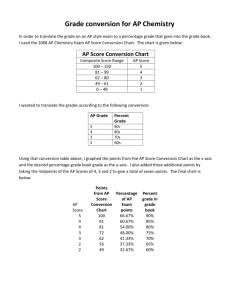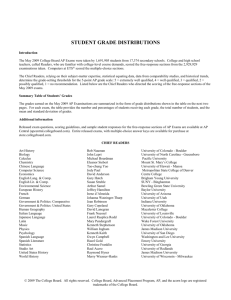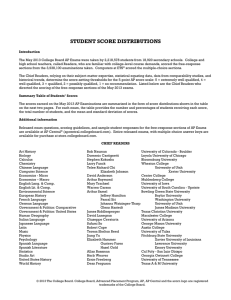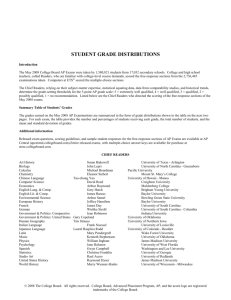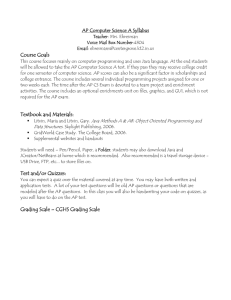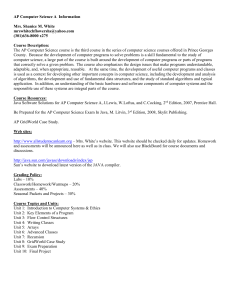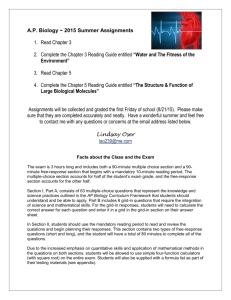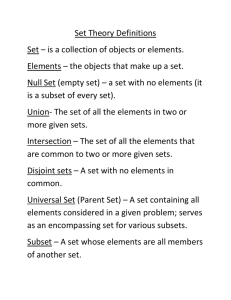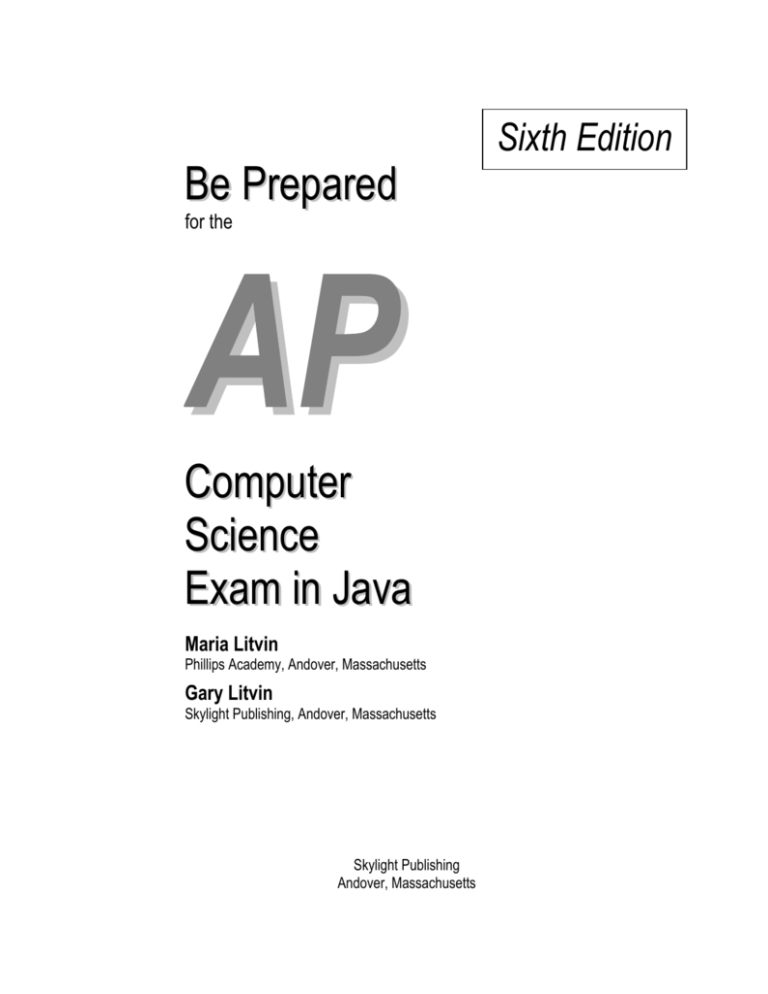
Be Prepared
for the
Computer
Science
Exam in Java
Maria Litvin
Phillips Academy, Andover, Massachusetts
Gary Litvin
Skylight Publishing, Andover, Massachusetts
Skylight Publishing
Andover, Massachusetts
Sixth Edition
Copyright © 2014 by
Maria Litvin, Gary Litvin, and Skylight Publishing
All rights reserved. No part of this publication may be reproduced,
stored in a retrieval system, or transmitted, in any form or by any
means, electronic, mechanical, photocopying, recording, or
otherwise, without the prior written permission of the authors and
Skylight Publishing.
Library of Congress Control Number: 2013918747
ISBN 978-0-9824775-3-3
Skylight Publishing
9 Bartlet Street, Suite 70
Andover, MA 01810
web:
e-mail:
www.skylit.com
sales@skylit.com
support@skylit.com
1 2 3 4 5 6 7 8 9 10
19 18 17 16 15 14
Printed in the United States of America
Chapter 1. Exam Format, Grading, and Tips
1.1. Exam Format and Materials
Copyright © 2014 by Skylight Publishing
Figure 1-1 shows the format of the AP Computer Science exam. The exam takes 3
hours of test time (plus breaks and time for instructions). It is divided into two
sections. Section I consists of 40 multiple-choice questions with a total allotted time
of 1 hour and 15 minutes (1.5 to 2 minutes per question on average). Section II
consists of four free-response questions with a total allotted time of 1 hour and 45
minutes (about 25 minutes per question). The free-response questions usually consist
of two or three parts each.
Section I: Multiple Choice
40 questions
1 hr 15 min
3 hours
Section II: Free Response
4 questions
1 hr 45 min
Figure 1-1. AP Computer Science exam format
No computers, calculators, other devices, books, or materials are allowed,
only paper, pencil and an eraser.
Pens are allowed, but we recommend that you use a pencil.
At the exam you will receive the Quick Reference page, both in your multiple-choice
questions booklet and again in your free-response questions booklet (in other words,
the same Quick Reference page will be given to you twice). The Quick Reference
provides a list of the Java library classes and their methods included in the AP subset.
Teachers can obtain a copy of the Quick Reference at AP Central (see “A Guide to AP
Central” at www.skylit.com). This document is provided for reference — it is
expected that you will already be very familiar and comfortable with the required Java
library classes before the exam.
1
2
CHAPTER 1 ~ EXAM FORMAT, GRADING, AND TIPS
The multiple-choice section is a mixture of questions related to general computer
science terms, program design decisions, specific elements of Java syntax, logical
analysis of fragments of Java code, properties of classes, and OOP concepts.
Copyright © 2014 by Skylight Publishing
The free-response section aims to cover a wide range of material: Java arithmetic,
algorithms, one- and two-dimensional arrays, strings, classes and interfaces, Java
library classes (within the AP subset), and so on. In past exams, students were asked
to write a constructor or a method that performs a specified task under a given header
for the method. The second part of the question often refers to the class or method
implemented in the first part, but each part is graded separately, and your
implementation of Part (a) does not have to be correct in order for you to get full credit
for Part (b). Part (c) may ask questions about your implementation or ask you to write
an additional method that uses Parts (a) and/or (b). In that case you are to assume that
the methods in the previous parts work as intended, regardless of what you wrote for
them.
Free-response questions may also include a “design” question, in which you are asked
to design and write a complete small Java class. Your design and implementation will
be graded based on the correctness of the implementation of your class, including the
encapsulation principle (declaring all instance variables private), and other criteria.
In the past, the AP CS exams included a specific case study, developed by the Exam
Development Committee. In 2008-2014, the case study was GridWorld.
Starting with the 2015 exam, neither GridWorld nor any other case study
will be part of the exams.
The College Board expects a typical AP CS course to include at least 20 hours of
computer lab work. The Development Committee has made available three sample
labs.
These labs are only examples designed to illustrate the scope and
difficulty of lab work in a typical course. The content and code in these
labs will not be tested on the AP CS exams.
1.2. The Java Subset
The Development Committee has defined a restricted subset of Java to be tested on the
exam. The purpose of the subset is to focus the AP CS program more on general
concepts than on the specifics of Java and to limit the scope, especially of material
related to the peculiarities of Java. The subset is described in The College Board’s
Computer Science A Course Description; we have a link to it from this book’s web
site www.skylit.com/beprepared/.
1.2 ~ THE JAVA SUBSET
3
What is in the subset? Actually, quite a bit:
•
Comments: /* ... */, //, and /** ... */, @param and @return tags.
•
boolean, int, and double primitive data types. (int) and (double) casts.
Other primitive data types, including char, are not in the subset and should
be avoided on the exam.
•
Assignment (=), arithmetic (+, -, *, /, %), increment/decrement (++, --),
compound assignment (+=, -=, *=, /=, %=), relational (<, >, <=, >=, ==, !=),
and logical (&&, ||, !) operators. Use only the postfix form of ++ and -- (k++
or k--), and do not use them in expressions.
•
+ and += operators for concatenating strings. String’s compareTo, equals,
length, substring, and indexOf(String s) methods. \n, \\, and \"
Copyright © 2014 by Skylight Publishing
escape sequences in literal strings.
•
System.out.print and System.out.println.
•
One- and two-dimensional arrays, array.length, arrays of objects, initialized
arrays such as int[] x = {1, 2, 3};
•
if-else, for, including the “for each” form, for(type x : values)...,
while, return. But do-while and switch are not included.
•
Classes. Constructors, the new operator, public and private methods,
static methods, static variables and static final variables (constants),
overloaded methods, null. All instance variables are private. Default
initialization rules are not in the subset and won’t come up on the exam.
•
Inheritance, interfaces and abstract classes, extends, implements. Calling a
superclass’s constructor from a subclass (as in super(...)). Calling a
superclass’s method from a subclass (as in super.someMethod(...)).
Passing this object to a method (as in otherObject.someMethod(this)).
•
NullPointerException, IndexOutOfBoundsException,
ArrayIndexOutOfBoundsException, ArithmeticException,
IllegalArgumentException.
4
CHAPTER 1 ~ EXAM FORMAT, GRADING, AND TIPS
•
Library classes, methods, and constants:
Object: equals(Object other), toString()
String: length(), substring(...), indexOf(String s)
Integer: Integer(int x), intValue();
Integer.MIN_VALUE and Integer.MAX_VALUE
Double: Double(double x), doubleValue()
Math:
abs(int x), abs(double x),
pow(double base, double exp), sqrt(double x),
random()
Also understand toString methods for all objects, the equals and
compareTo methods for String, Integer, and Double. Comparable<T>
interface is not in the subset, but is worth knowing.
Copyright © 2014 by Skylight Publishing
•
The List<E> interface and the ArrayList<E> class (see Section 2.6).
If you feel you must stray from the subset in your free-response solution,
you might have misunderstood the problem and be making it harder than
it is.
At the same time, it is OK to use such features outside the subset as Math.min(...)
and Math.max(...) methods, ArrayList’s contains and remove(object)
methods, and other simple tools that all exam readers are familiar with.
Things that are not in the AP subset and should be avoided include the following:
•
Java syntax abominations, such as the ?_:_ operator and the “comma” operator
•
++ and -- in expressions (as in a[i++])
•
Primitive data types other than boolean, int, and double (char, long,
float are not in the subset)
•
Bitwise logical operators and shift operators: ~, &, |, ^, <<, >>.
Also not in the subset and will not be tested:
•
The switch statement, the do-while loop, break and continue in loops
•
The prefix form of ++ and -- operators (++k, --k)
•
Library classes (such as StringBuffer, Arrays, DecimalFormat, etc.),
unless specifically listed in the subset
•
checked exceptions and try-catch-finally statements
•
System.in and Scanner; any input and output other than
System.out.print and System.out.println
•
enum data types
1.3 ~ GRADING
1.3. Grading
The exam is graded on a scale from 1 to 5. Grades of 5 and 4 are called “extremely
well qualified” and “well qualified,” respectively, and usually will be honored by
colleges that give credit or placement for the AP exam in computer science. A grade
of 3, “qualified,” may be denied credit or placement at some colleges. Grades of 2,
“possibly qualified,” and 1, “no recommendation,” will not get you college credit or
placement.
Table 1-1 presents published statistics and grade distributions for the 2012 and 2013
exams. In 2013, 31,117 students took the exam; 53.2 percent scored 4 or 5.
Copyright © 2014 by Skylight Publishing
AP Computer
Science A
2013
2012
Number
%
Number
%
Students
31,117
100.0
26,103
100.0
Grade:
5
4
3
2
1
8,268
8,276
4,339
2,168
8,066
26.6
26.6
13.9
7.0
25.9
6,171
6,351
4,075
2,013
7,493
23.6
24.3
15.6
7.7
28.7
4 or 5
16,544
53.2
12,522
48.0
Table 1-1. 2013 and 2012 grade distributions
The multiple-choice and free-response sections weigh equally in the final
grade.
The College Board uses a weighted combination of the multiple-choice (MC) and
free-response (FR) scores to determine the final total score:
totalScore =
MC_coeff * countCorrect + FR_coeff * FR_score;
One point is given for each correct answer to a multiple-choice question.
There is no penalty for giving a wrong answer to a multiple-choice
question, so it is a good strategy not to leave any answers blank.
5
6
CHAPTER 1 ~ EXAM FORMAT, GRADING, AND TIPS
Solutions to free-response questions are graded by a group of high school teachers and
college professors. Scores are based on a rubric established by the Chief Reader,
Exam Leader, and Question Leaders. Each free-response question is graded out of 9
points, with partial credit given according to the rubric.
Copyright © 2014 by Skylight Publishing
The final score is obtained by adding the MC and FR weighted scores. The MC and
FR coefficients are chosen in such a way that they give equal weights to the
multiple-choice and free-response sections of the exam. For example, if the exam has
40 multiple-choice questions and 4 free-response questions, weights of 1.0 for
multiple-choice and 1.1111 for free-response will give each section a maximum total
of 40, for a maximum possible total score of 80.
Every year over the summer the College Board releases sample solutions to freeresponse questions and grading rubrics. Every few years the College Board releases a
complete exam, including a diagnostic guide for multiple-choice questions, grading
rubrics for free-response questions, and the cut-off points for grades.* Table 1-2
shows the cut-off points used for the 2004 and 2009 exams. The maximum possible
composite score was 80 (1.00 * MC + 1.1111 * FR). In those years there was a 1/4
point penalty for incorrect answers to multiple-choice questions; there is no penalty
now. The table shows both the actual cut-offs and the cut-offs adjusted for no-penalty
grading. The cut-off points are determined by the Chief Reader in consultation with
the College Board and may vary slightly from year to year based on the score
distributions and close examination of a sample of individual exams. In 2009, 77.5
percent or more would get you a 5.
2004
AP
Grade
5
4
3
2
1
Actual
63 - 80
49 - 62
39 - 48
32 - 38
0 - 31
2009
Adjusted
for no
penalty
AP
Grade
65 - 80
52 - 64
43 - 51
36 - 42
0 - 35
5
4
3
2
1
Actual
60 -80
44 - 59
33 - 43
25 - 32
0 - 24
Adjusted
for no
penalty
62 - 80
47 - 61
37 - 46
29 - 36
0 - 28
Table 1-2. Score-to-grade conversion.
Statistical analysis of the 2009 exam shows that over 98.5 percent of
students who answered correctly at least 27 out of 40 questions on the
multiple-choice section received a 4 or a 5 for the whole exam.
*
When this book went to print, 2009 was the last released exam. See
www.skylit.com/beprepared for the latest updates.
1.5 ~ EXAM TAKING TIPS
7
1.4. College Credit
Most colleges will take your AP courses and exam grades into account in admission
decisions if you take your exams before your senior year. But acceptance of AP exam
results for credit and/or placement varies widely among colleges. In general, the AP
Computer Science course corresponds to a CS-1 course (Introductory Computer
Science or Computer Programming I), a one-semester course for computer science
majors. Some colleges may base their decision on your grade, and some may not give
any credit at all.
Copyright © 2014 by Skylight Publishing
The AP program in computer science is a rigorous and demanding program that is
comparable to or exceeds the level of the respective first-semester computer science
courses at most colleges.
If you plan to major in computer science and your college of choice does
not recognize a good grade on the AP exam for credit and/or placement,
you should examine the reasons carefully. Decide for yourself whether
these reasons are valid or just stem from the bias of that college or its
computer science department.
1.5. Exam Taking Tips
Some things are obvious:
•
If you took the time to read a multiple-choice question and all the answer choices,
take an extra ten seconds and guess. Most likely you have eliminated one or two
wrong answers even without noticing. Do not leave any multiple-choice
answers blank: there is no penalty for wrong answers.
•
If a common paragraph refers to a group of questions and you took the time to read
it, try each question in the group.
•
Do read the question before jumping to the code included in the question. Notes to
multiple-choice questions in our practice exams might show you some shortcuts.
•
In questions with I, II, III options, work from the answers; for example, you might
be able to eliminate two or three answer choices if you are sure that Option I
doesn’t work.
There are a few important things to know about answering free-response questions.
8
CHAPTER 1 ~ EXAM FORMAT, GRADING, AND TIPS
Remember that all free-response questions have equal weight. Don’t
assume that the first question is the easiest and the last is the hardest.
In a nutshell: be neat, straightforward, and professional; keep your exam
reader in mind; don’t show off.
More specifically:
1. Stay within the AP Java subset, except for a few obvious shortcuts, such as
Math.max(...) and Math.min(...).
Copyright © 2014 by Skylight Publishing
2. Remember that the elegance of your code does not count. More often than not, a
brute-force approach is the best. You may waste a lot of time writing tricky,
non-standard code and trick yourself in the process or mislead your exam reader
who, after all, is only human. Your exam reader will read your solution, but will
not test it on a computer.
3. Superior efficiency of your code does not count, unless the desired performance of
the solution is specifically stated in the question.
4. Remember that Parts (b) and (c) of a question are graded independently from the
previous parts, and may actually be easier: Part (a) may ask you to write a method,
while Part (b) or Part (c) may simply ask you to use it. It is common for method(s)
specified in Part (a) to be called in subsequent parts. Do so, even if your Part (a) is
incorrect or left blank. Do not re-implement code from earlier parts in later parts
— you will waste valuable time and may lose points for doing so.
5. If a question presents a partial definition of a class with certain methods described
but not implemented (“implementation not shown”), call these methods whenever
appropriate in your code — do not write equivalent code yourself.
6. Bits of “good thinking” count. You may not know the whole solution, but if you
have read and understood the question, go ahead and write fragments of code that
may earn you partial credit points. But don’t spend too much time improvising
incorrect code.
7. Don’t waste your time erasing large portions of work. Instead, cross out your
work neatly, but only after you have something better to replace it with. Do not
cross out a solution if you have no time to redo it, even if you think it is wrong.
You won’t be penalized for incorrect code and may get partial credit for it. Exam
readers are instructed not to read any code that you have crossed out. But if you
wrote two solutions, be sure to cross one out: otherwise only the first one on the
page will be graded.
1.5 ~ EXAM TAKING TIPS
9
8. Read the comment above the method header quickly — it usually restates the task
in a more formal way and sometimes gives hints. Assume that all preconditions
are satisfied — don’t add unnecessary checks to your code.
9. One common mistake is to forget a return statement in a non-void method.
Make sure the returned value matches the specified type.
10. Do not ignore any hints in the question description. If an algorithm is suggested
for a method (as in “you may use the following algorithm”), don’t fight it, just
use it!
Copyright © 2014 by Skylight Publishing
11. Remember that the exam readers grade a vast number of exams in quick
succession during a marathon grading session every June. Write as neatly as
possible. Space out your code (don’t save paper).
12. Always indent your code properly. This helps you and your exam reader. If you
miss a brace but your code is properly indented, the reader (as opposed to a Java
compiler) may accept it as correct. Similarly, if you put each statement on a
separate line, a forgotten semicolon may not be held against you.
13. Follow the Java naming convention: the names of all methods, variables, and
parameters start with a lowercase letter. Use meaningful, but not too verbose,
names for variables. count may be better than a; sum may be better than temp;
row, col may be better than i, j. But k is better than loopControlVariable.
If the question contains examples of code with names, use the same names when
appropriate.
14. Don’t bother with comments; they do not count and you will lose valuable time.
Occasionally you can put a very brief comment that indicates your intentions for
the fragment of code that follows. For example:
// Find the first empty seat:
...
...
15. Don’t worry about imports — assume that all the necessary Java library classes
are imported.
16. Code strictly according to the specifications and preconditions and postconditions.
Avoid extraneous “bells and whistles” — you will lose points. Never add
System.out.print/println in solutions unless specifically asked to do so.
Do not read any data in your method — it is passed in as a parameter.
10
CHAPTER 1 ~ EXAM FORMAT, GRADING, AND TIPS
17. Do not use in your code specific numbers, strings, or dimensions of arrays given as
examples in explanations of questions. If the question says: “For example, a twodimensional array pixelValues may contain the following image” and shows an
array of 4 rows by 5 columns, do not use 4 and 5 in your code — make your code
work with an array of any size.
18. Don’t try to catch the exam authors on ambiguities: there will be no one to hear
your case, and you’ll waste your time. Instead, try to grasp quickly what was
meant and write your answer.
Copyright © 2014 by Skylight Publishing
19. Don’t quit until the time is up. Use all the time you have and keep trying. The test
will be over before you know it.
Other Computer Science and Mathematics
Titles from
Skylight Publishing
Java Methods: Object-Oriented Programming and Data Structures,
Second AP Edition ISBN 978-0-9824775-7-1
250 Multiple-Choice Computer Science Questions in Java,
E-Edition Part 978-0-9727055-J-E
100 Multiple-Choice Questions in C++,
E-Edition Part 978-0-9654853-C-E
Mathematics for the Digital Age and Programming in Python,
Second Edition ISBN 978-0-9824775-4-0
Be Prepared for the AP Calculus Exam, Second Edition
ISBN 978-0-9824775-5-7
800 Questions in Calculus with Solutions, E-Edition
Part 978-0-9727055-E-E
Calculus Calculator Labs Student Pack
Part 978-0-9727055-S-L
Calculus Calculator Labs Teacher Pack
Part 978-0-9727055-T-L
www.skylit.com
sales@skylit.com
Toll free: 888-476-1940
Fax: 978-475-1431
Skylight Publishing, 9 Bartlet Street, Suite 70, Andover, MA 01810

